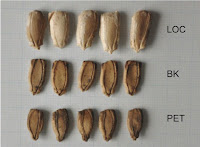A new article by Angela Schlumbaum and Patricia Vandorpe in Vegetation History and Archaeobotany provides a review and new data on Roman era bottlegourds in Europe. Despite the fact the bottlegourds originated in eastern Africa (Decker-Walters et al 2004) and most likely were carried to Asia sometime in the Pleistocene (and thence to the Americas-- as discussed in my short contribution on East Asian Neolithic and Jomon gourds in Economic Botany 2010), gourds were only introduced to Europe in the Roman period. New aDNA confirms, at least where DNA markers could be extracted, that these were Asian (rather than African). Seed morphometrics are reported from several modern and archaeological populations, and while the L:W ratio does not clearly demarcate Asian versus African genotypes, it does seem to suggest multiple morphotypes (at least two) in Roman Europe, although both would fit within a broader range of Asian diversity.
Some thoughts on recent publications in archaeobotany and agricultural origins. Opinions and views on the evolution and history of crops. Memorials of archaeobotanists we have lost. The author's research has previously been supported by grants from the ERC and NERC.
Subscribe to:
Post Comments (Atom)
-
It’s with great sadness we bring you the news that Gordon Hillman died on Sunday 1 st July. He is survived by his daughter Thilaka, and ...
-
Many have been excited this week about headlines claiming marijuana (Cannabis) was domestication in China 12,000 years (making it the first ...
-
wild Gallus gallus spadiceus The past week saw the publication of a landmark genomic study on chickens ( Wang et al 2020, Cell Researc...
-
Cyprus is the first place that we know that crops and livestock were spread to by human action. This even took place before domesticat...
-
Alison and Oryza nivara in Orissa, Sept. 2010 Alison Weisskopf (1960-2018), passed away peacefully in hospice in the presence of her...
-
Recently published on-line in Geology is a paper which might not appear on the surface to be very archaeobotanical, but which is important ...







2 comments:
Hello mr Dorian! I`m Yésica from Argentina and i´m interested in arquaeobotany. I don´t know much... but i think it is the topic i was looking for to work as a scientist. I´ll appreciate any information you can send me.
Yours,
Yésica.
unmillondeestrellas@gmail.com
Hello mate greaat blog post
Post a Comment